Before the modern era of refrigeration, people had to find natural ways to keep fruits and vegetables from spoiling. Ancient peoples realized that they could build storage areas below the Earth’s surface which would be much cooler.
Since these underground structures were commonly used to store root vegetables, they have come to be referred to as ‘root cellars’.
There is evidence of the use of root cellars as far back as 40,000 years, which means there are thousands of years worth of mistakes and lessons learned that we could all use to improve our root cellars.
Why Build a Root Cellar?
Modern refrigeration requires the use of electricity, which makes maintaining the temperatures needed to keep food from spoiling difficult, if not impossible, in a grid down situation.
Related: How To Make a Mini Root Cellar In Your Backyard In Less Than Two Hours
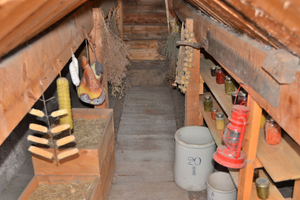
However, a properly designed and constructed root cellar will keep fruits, vegetables, and nuts from spoiling without the need for electricity.
While building a root cellar is a significant undertaking, it is a worthwhile investment if your goal is off-grid living or EMP preparedness.
There are, however, many mistakes that we must avoid at all costs when designing and building a root cellar.
Not Enough Ventilation
A root cellar must maintain temperature and humidity and enough ventilation to allow fresh air to come in and stale air to exit.
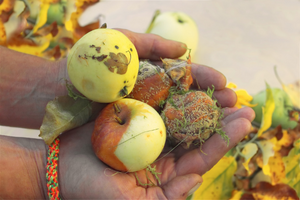 One of the reasons for the need to exchange air is the ethylene gas that some vegetables and fruits produce. Too much of this gas will cause other foods to spoil more rapidly.
One of the reasons for the need to exchange air is the ethylene gas that some vegetables and fruits produce. Too much of this gas will cause other foods to spoil more rapidly.
Another reason that ventilation is needed is to maintain an appropriate humidity level.
Too little humidity will dry out the food, and too much moisture will cause mould, mildew, and rot. So install vents high up to remove the stale air and gas and vents closer to the ground to bring in the fresh air.
When installing ventilation, be sure to cover the opening with a screen to keep the critter out and purchase vents that allow you to regulate the airflow.
Keeping Fruits and Vegetables Too Close Together
I mentioned ethylene gas in the last section, which is a gas emitted by certain fruits and vegetables that can harm other fruits and vegetables. Therefore you must keep these foods separate.
Related: 10 Foods You Should Never Store Together
Some foods that emit ethylene gas are: apples, bananas, blueberries, cantaloupe, citrus fruit, grapes, green onions, honeydew, melons, mushrooms, nectarines, okra, papayas, passion fruit, peaches, pears, peppers, plantains, plums, quinces, tomatoes, watermelons.
Some foods that are negatively affected by ethylene gas are: asparagus, broccoli, brussels sprouts, cabbage, carrots, cauliflower, cucumbers, eggplant, endive, green beans. kale, kiwi fruit, leafy greens, lettuce, parsley, peas, peppers, potatoes, romaine lettuce, spinach, squash, sweet potatoes, watercress, yams.
Neither of these lists is exhaustive, and before you start filling your root cellar, it is imperative that you thoroughly research the foods you plan on storing.
It is also essential that you plan to manage ethylene gas production inside your root cellar, arranging the shelves and storage areas with ethylene gas production in mind.
Not Being Dark Enough
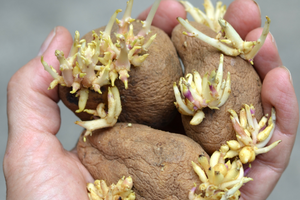 Light is the nemesis of many foods you will want to store inside your root cellar. For example, exposure to light can cause potatoes to sprout and bleach out the color and nutrients of other fruits and vegetables.
Light is the nemesis of many foods you will want to store inside your root cellar. For example, exposure to light can cause potatoes to sprout and bleach out the color and nutrients of other fruits and vegetables.
If your root cellar has a window, you need to cover it to keep the light out.
Another option is to cover the fruits and vegetables with burlap to lessen the effect of any light that finds its way into the root cellar.
Not Monitoring Temperature and Humidity
There is no excuse for not having a robust method of dialing in and maintaining the temperature and humidity levels within your root cellar.
A wide range of devices will keep track of both temperature and humidity, and most of them are not very expensive.
Many devices will provide you with this information and track trends in the temperature and moisture over time. There are even devices that will send this data to your smartphone.
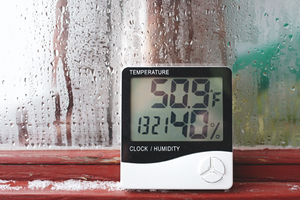 As you monitor the conditions inside your root cellar, you can make wiser decisions on regulating the ventilation to achieve the most consistent results.
As you monitor the conditions inside your root cellar, you can make wiser decisions on regulating the ventilation to achieve the most consistent results.
The bottom line is that if you do not have something that will tell you what the temperature and humidity levels are, you can not effectively protect your supplies.
Using Concrete Floors
The problem with concrete floors is that they keep the moisture held in the dirt below it from entering the root cellar. Concrete also has a nasty habit of holding in heat, which we do not want for a root cellar.
If you are constructing a root cellar from scratch and choose what your floor will be made of, plain dirt is always the better option.
A dirt floor allows the moisture in the ground to enter the cellar and also aids in keeping the air cool.
 If your root cellar already has a concrete floor, there is no need to break out the jackhammer.
If your root cellar already has a concrete floor, there is no need to break out the jackhammer.
As long as you are mindful of the conditions within the confines of the space, you can make the necessary adjustments to have a fully functional root cellar.
Going In and Out Too Often
Root cellars work best by keeping the cool, moist air inside where it is needed. It would be best if you kept the door of your root cellar closed as much as possible to maintain optimal conditions inside.
Every time you open the door, you allow heat to enter and cool air to escape. Not to mention that your body heat is also heating the air inside. To reduce the need to go into the root cellar, don’t store other items inside that you need regular access to.
Your root cellar is for food only, and the only reason you should be opening the door is to put more food inside or take some food out. When you need to take food out, plan ahead and take enough for a couple of days to avoid having to go inside daily.
A root cellar is an excellent backup to the modern refrigeration we all enjoy today. It is also a great way to store fruits, vegetables, nuts, and canned goods that you would regularly use.
Building a root cellar and using it regularly will give you the knowledge and skills to maintain your food security during a grid-down situation.
We must take the time to learn from the mistakes of others so that we can construct and use a root cellar that will help guarantee our food security in the event of a widespread disaster or the loss of grid power.
You may also like:
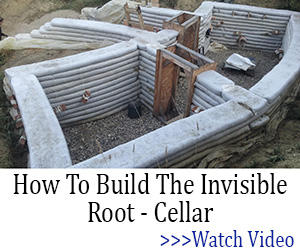 The Best Way to Train Your Dog For Hunting And Security
The Best Way to Train Your Dog For Hunting And Security
5 Ingenious Ways To Refrigerate Your Food Without Electricity (Video)
How To Start A Survival Garden From Scratch
Things You Throw Away That You Should Add To Your Stockpile Instead

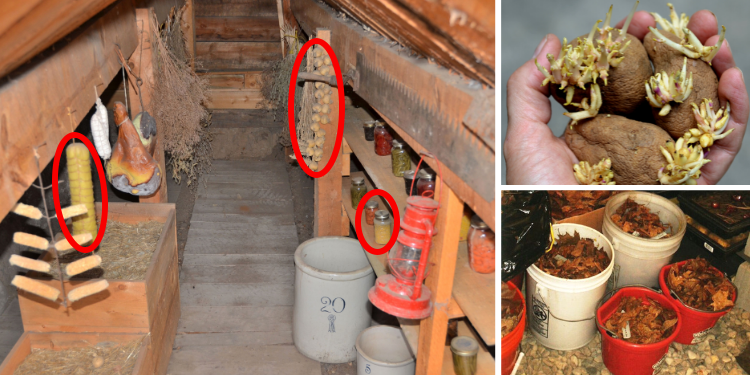













Looking into builing on but i would like to put it under a shed but that doest require way to much money in a poured wall and roof. So it might come down to do a simple dug out with feeled trees and and a simple roof.
I have no experience of my own but an article I read suggested adding a wire mesh, such as hardware cloth, to the felled trees walls if there are gaps that burrowing critters can crawl through to get at your food.
Got an older house with a large covered porch? In the basement, on the wall adjacent to the porch, make an opening 3ft wide x 4ft high at the floor of the basement. Also make a hole on the basement floor 3ft wide to dig down 2ft for stairs. Dig out a room under the porch leaving 3ft+ undisturbed soil as the roof of your cellar. If your basement isn’t a walk-out the better – I wouldn’t even put a door on the cellar in that case, leaving the cool basement to keep the cellar cool and ventilated. Your dirt walls and floor in the cellar room will also allow it to breath. Usually the soil (crawl space) under the deck of a covered porch remains dry, this would keep your soil stable and not worry about water coming in. Keep the size of the cellar room small.
Many of the older homes circa early 1900s 1920s here in the city and city suburbs have root cellars located under an enclosed front porch or front entrance that were built in as part of the original design of the house. These are basically unheated rooms that are entered through a door in the basement. Some of these cold storage rooms are still used as root cellars or wine cellars. Most likely Sears homes and the plans are still available.
I wonder if a large plastic septic tank would work well for a root cellar. Some have round access holes with caps which are large enough for a person to fit through.
Anyone have any experience with using a Plastic Septic Tank for long term food storage or for a Root Cellar?
I have thought about trying that also!!
The aforementioned ventilation would be your biggest problem. You want your cellar to breath. Also worth mentioning, rotting POTATOES (or Potatoes exposed to light that have started turning green) especially off-gas solanine which can and has caused death many times in the past.
So I’m lost on how to ventilate it. Would a rv ceiling fan just draw in moisture(too much moisture)? And if it’s pretty much airtight, where would an in flow vent go? I enjoy watching the Rainey’s help out homesteaders, but can’t recall Marty mentioning ventilation…
Mike: Every old-time, built a century or more ago root cellar had a pipe that ran up the middle of the dome and had a cap on it to stop rain. And, of course, hardware cloth to keep critters out. It’s a very simple idea. Here, Arizona, I’d add a bucket of water to add to the humidity. But, best bet here where the ground rarely gets frost in it, leave root crops in the ground. We don’t eat much potatoes because there are other things, like yucca root and so on. niio
These tanks, especially the extra heavy gauge cistern tanks look good at first, but they are very light. A 1200 gallon cistern tank can be easily picked up by 2 men and if not securely anchored to a concrete slab will tend to float up out of the ground in just a few years. they are meant to be kept full or nearly full of water most of the time.
also, they are designed for inner pressure. so if you only have outter pressure. ie burry them, you have an unstable situation and can collapse with out some form of inner structure for walls and roof. try to bury a old fridge door up
Hi David, What you say is true in wet silt or mud in general but if it’s dry that won’t happen. In the sixties at Richmond BC. they installed metal underground gasoline tanks at a new gas station. It was a Friday and when they came back Monday the tanks had floated up out of the ground. And yes when they reinstalled them they covered them with concrete. lol. So what you say is something people should keep in the back of their mind just in case.
Apparently you missed the class on if you can’t say anything nice say nothing at all.
True . And if they floated up they weren’t properly installed. My brother installs underground tanks.
Gods Love is Pure , not selfish, not rude, not proud , not evieous , not self seeking
but always thinking about the other person , that s why Jesus christ died on the cross as a sacrafice for mankinds sin and to provide a lamb for the payment of our sin.
Jesus is true love , kindness, gentleness, hope , and peace , forgiving to the end
you would seem interested in my buldge.
Thanks for the info!
I’m picturing an old refrigerator as the entrance to the root cellar. Anyone think that may be an issue?
Lol. Poor Chuck.
Yeah, I was just thinking in terms of having a good seal when closed.
I have an old root cellar on my place that looks great except that water drains into it during the wet spring months so one thing we’re going to have to do is create drainage AROUND the root cellar so that it maintains less moisture.
well well another moron who thinks her or she is perfect and enjoys pointing out that others are in perfect and can not finger type as well as others.
if we can read and understand it we dont need you azzhole comments.
humm looks like they have more likes than you.
In a grid down situation, it might be difficult to know the temperature and humidity if you are relying on electric models or even battery operated ones. At some point both might be rare commodities. I do have an old barometer that supplies temperature and humidity info, so I’d suggest using one of those and perhaps a second method to see how accurate the barometer is. Because it might be the only thing that’ll continue working over time. Also, you’d likely want to track temperature and humidity both near the floor of your root cellar and near the ceiling to note the differences. That info can help you plan the best locations for each item.
You’d also want to check the items in your root cellar at least weekly, taking care to use up the ones that look to be going bad first. And store only sound food and using up first snything with blemishes such as potatoes speared by the hoe or shovel.
Yes there is something good. He keeps everybody thinking so it’s a good thing. lol.
So the crawl space under the addition portion of my house seems cooler, much cooler winter and spring, but doesn’t freeze. It’s like 36” high with a slab floor. Would it be possible to somehow modify that space to adapt to root cellar requirements?
what is desired temp and humidity for root cellar ?
I was wondering the same thing. I’ll research it for myself – if i find a suitable answer, i’ll come back and provide it.
Found the following at:
https://www.almanac.com/content/root-cellars-types-and-storage-tips#:~:text=To%20work%20properly%2C%20a%20root,work%20in%20warm%2C%20southern%20climates
“To work properly, a root cellar must be able to hold a temperature of 32º to 40ºF (0° to 4.5°C) and a humidity level of 85 to 95 percent. This means that root cellars may not work in warm, southern climates.”
Ugh
So what do we sun belters do?
I bought this program last year. I dont have property to build it yet. I will be tweaking it a bit, like maybe bigger. And yes they are fairly quick to respond to answer your questions. This will be onrle of the first things I build when I get property. Best thing I ever purchased.
Location and ground conditions call for adjustment. I know many cellars that don’t have vents because of where they’re located.
I agree with Eve. You’re here to help not be rude or smart butt.
This is some serious stuff to those who do it please don’t cause them stress. Be as helpful as you would want others to be to your own family.
Very Important to the prepper
using the earth as a constant for cooling and storage
lost in the culture of fast , lazy , people who depend on society for thier every need
This concept yu can find in many sites and do it well
just like if you go into abandoned mines, shafts and tunnels
you feel the cool natural breeze and stable temperature
but the draw back is
Moisture, molds, spores and mushrooms
be smart , think it thru , plan very well and like a ice box , insulate , build back to last
Food will keep at a constant temp , much better than at a changing temp
depending on area , you must build in a proper drainage system for run off and ground water
check the water table s of your area and see at what depth the water is natural
in the desert the table s can be as low as 75 feet or deeper
in the wet areas the tables will be at 1 foot
swamps or wetlands need more consideration and water blocks with plastic, rubber or barriers
like when you build , you shield from the ground moisture with a block
same principle
most can be found on Inet and researched for proper build
under building or in side of mountain , cave are best no sun
In the normal process of sewage break-down in a septic tank produces noxious gases. Therefore all new septic tanks sold today are vented or have the capacity to be vented.
when i was a kid, we had a cellar. we paid a guy with a backhoe to dig it. it was maybe 12 ft. by 12ft. and about 10 ft. deep. we put railroad cross ties at each corner and in the middle. put long cross ties across the top. and a vent right in the middle. covered it with dirt, made a set of stairs and a door, it was originally made as a storm shelter, panhandle of Texas, lots of tornadoes. we kept potatoes, carrots, onions and some home canned veges in it. worked great, never had a problem with critters, except crickets. and the food was good for along time. miss those days.